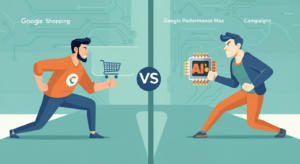You’ve probably heard of Search Engine Marketing and SEM. Maybe you’ve even nodded along when you’ve heard it mentioned. Or perhaps you have a general idea of what it’s all about but need help with the details.
Either way we’re here to help. You won’t be an expert by the time you’ve finished this glossary but you’ll have a clue.
What is SEM?
Search Engine Marketing, or SEM, is a digital marketing strategy to get your website visible in search engine results pages (SERPs). Unlike Search Engine Optimisation (SEO) which is about earning traffic through unpaid or organic listings, SEM is about paid advertising to get your website to show up when people search for specific keywords. The main aim of SEM is to drive targeted traffic to a website and convert visitors into customers.
SEO vs SEM?
Both Search Engine Optimisation (SEO) and Search Engine Marketing (SEM) aim to get your website visible in search engine results pages (SERPs) but they do it differently.
- SEO is about optimizing your website’s content and structure to rank in organic (unpaid) search results. This means keyword optimization, creating high-quality content, improving site speed, and building backlinks.
- SEM is about paid strategies to show up in search results. This means PPC advertising where businesses bid on keywords to show up at the top or bottom of SERPs.
The main difference is that SEO is a long-term strategy that builds organic visibility over time, SEM can give you immediate visibility through paid ads but requires ongoing investment.
What are SEM Keywords?
SEM keywords are the specific words or phrases that advertisers bid on to show their ads to people searching for those terms. These keywords are chosen based on the relevance to the advertiser’s products or services, the search volume they get, and the competition from other advertisers. Good keyword research is about finding high-volume, low-competition keywords that will give you the best return on investment (ROI) for your campaign.
What are the Three Types of SEM?
- Pay-Per-Click (PPC) Advertising: This is the most common form of SEM, where you pay a fee each time your ad is clicked. Google Ads is the most popular platform for PPC.
- Cost-Per-Thousand Impressions (CPM): This type of advertising charges you based on the number of impressions (times your ad is shown) rather than clicks. Good for brand awareness campaigns.
- Ad Auction Models: These are bidding for ad placement in search results. You set a maximum bid for how much you’re willing to pay for a click on your ad and the highest bidder gets the ad placement.
Now that you understand the basics and types of SEM you can create and manage better advertising campaigns to increase your online visibility and drive traffic to your website.
Is Google Ads an SEM?
Yes, Google Ads is part of SEM. Google Ads allows businesses to create and show ads on Google’s search engine and its advertising network. By bidding on specific keywords you can get your ads to show up in search results when people search for those terms. Google Ads has tools and metrics to help you optimise your campaigns so it’s part of any SEM strategy.
SEM vs Search Ads?
SEM is broader than just search ads. Search ads are a type of SEM that targets people through search engine results, SEM also includes display ads, shopping ads and other forms of paid digital marketing. All search ads are part of SEM but SEM also includes other ad formats and strategies to increase visibility and traffic.
Now let’s get into the glossary.
| Glossary of SEM Terms
Ad Rank is a Google AdWords metric that determines ad position and is a product of the bid amount, Quality Score, and expected ad extension impact. Recalculated each time an ad is chosen for an auction, ads with higher scores earn better positions. Ad Position refers to where an ad appears on the search engine results page (SERP). Ads with the best ad rank earn the top (i.e., 1st, 2nd, 3rd, etc.) positions. Auction is what’s triggered every time a search engine user initiates a search that is relevant to keywords that more than one advertiser has bid upon. Those advertisers’ ads “compete” with one another for best ad rank and subsequently appear on the search engine results page (SERP) in the ad position they earn. Bid Amount is the highest amount an advertiser is willing to pay per click. Bid amounts can either be set manually (by keyword, ad placement, etc.) or automatically (using various automated bid strategies). Depending on the quality of an ad, as well as that of the competition’s, actual cost per click (CPC) may fall well below the bid amount. CPC (Cost Per Click) is the amount of money an advertiser actually pays when someone clicks on an ad. It is calculated within Google AdWords by dividing the numeric ad rank of the competing ad in the position directly beneath the clicked-on ad by the quality score of the clicked-on ad and adding one cent. So: Ad Rank of Ad Directly Below Ad Quality Score + $.01 = Actual CPC. This formula can differ slightly depending on platform. CTR (Click-Through Rate) is the ratio of how many clicks an ad has received divided by the number of impressions it has had and can be used to measure both keyword and ad performance. Impression occurs each time an ad is shown on a search engine results page (SERP) and refers only to an ad being seen, not clicked. Keyword is a word or phrase that an advertiser chooses for its relevance to terms people enter into search engines (e.g., “winter coats” is a good keyword for someone selling parkas). Landing Page is the page on an advertiser’s website that a user is routed to upon clicking an ad. Negative Keyword is a word or phrase that an advertiser chooses in order to exclude certain search terms. For example, adding the word “free” as a negative keyword will ensure that an ad isn’t shown to people who are using the search term “free.” PPC (Pay Per Click) is a model of internet marketing which involves advertisers paying for each click that brings a prospective customer to their website, rather than earning those clicks organically. In essence, paying per click means better ad positioning and greater ad visibility Quality Score is a Google AdWords metric that measures an ad’s quality on a scale from one to ten by using three components (expected click-through rate [CTR], relevance, and landing page experience) to determine how useful the ad will be to the user. Query is the word or phrase that someone enters into a search engine and, in the case of PPC advertising, triggers an auction. SEM (Search Engine Marketing) refers to the use of both paid (PPC) and unpaid (SEO) advertisements on an internet search engine platform for the purpose of increasing traffic flow to websites, raising visibility, and cuing conversions. SEO (Search Engine Optimization) is a model of unpaid internet marketing which involves creating high-quality advertisements (preferably in large quantities) for the purpose of beating competing ads and winning clicks organically. SERP (Search Engine Results Page) is the page that displays the results of a search engine user’s query. |
Continuous Optimization in SEM
Paid SEM is 24/7 because the online search landscape is always changing. No matter how good or effective your ad campaign is one day, that will change as (sometimes just a little) time passes.
Continuous testing, metric analysis, and optimization are required to stay competitive, keep costs low, and engage users. Because of all the variables involved, we can’t stress enough that SEM is either something that should be studied thoroughly before attempting OR best left to experts.
Here are some tips:
- Review and Adjust Bids: Make sure you’re bidding the right amount to show ads without overspending.
- Analyze Metrics: Use CTR, CPC and conversion rates to evaluate and adjust your campaigns.
- Test Ad Copy and Keywords: Continuously test different ad texts and keywords to see what works best.
- Optimize Landing Pages: Make sure the pages users land on after clicking your ads are conversion-optimized.
By continuously optimizing your SEM you can stay ahead of the game and get more ROI.
In a Nutshell
Now you know the basics of Search Engine Marketing (SEM).
Whether it’s SEM vs SEO, Google Ads, or continuous campaign optimization, this glossary will help you navigate SEM better.
Remember SEM is a 24/7 job, if you need help or professional management of your SEM campaigns, StubGroup is here for you.
StubGroup is a PPC agency, a Premier Google Partner, and in the top 3% of all Google Partners globally. We create and manage ad campaigns for big and small businesses across multiple search engines. Get in touch to ask us a question or schedule your company for a free consultation today.




